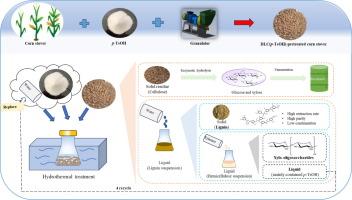对甲苯磺酸致密化预处理促进了玉米秸秆全组分的综合分离和利用
IF 9
1区 工程技术
Q1 ENGINEERING, CHEMICAL
引用次数: 0
摘要
近年来,木质纤维素全组分的综合分离与利用受到了广泛的关注。与传统的预处理方法相比,p-TsOH预处理可以很好地去除木质素,保留纤维素。本研究开发了一种新的预处理方法:用化学剂(p-TsOH)致密木质纤维素生物质,然后用水热处理(DLCH(p-TsOH))将木质纤维素组分分馏,p-TsOH有效回收。结果表明,DLCH(p-TsOH)预处理的总p-TsOH用量(2.40 g/g生物质)远低于常规p-TsOH预处理,木质素提取率提高了12.30 %。所得木质素纯度高达97.60 %,其中β-O-4键保留率高达89.64 %,具有较高的增值潜力。经DLCH(p-TsOH)预处理的玉米秸秆在固体负荷为20% %时具有较高的生物转化效率,总糖浓度为184.70 g/L,乙醇滴度高达85.40 g/L。木聚糖酶预处理产物的低聚木糖(XOS)得率为41.22 %,显著高于传统p-TsOH预处理玉米秸秆的31.25 %。p-TsOH经循环利用,4次循环后木质素提取率仍在70% %以上。总体而言,与传统p-TsOH预处理玉米秸秆相比,DLCH(p-TsOH)预处理玉米秸秆的乙醇产量提高了20.83 %,XOS产量提高了41.30 %,木质素提取率提高了12.30 %。该研究表明,DLCH预处理是一种有效且环境可持续的玉米秸秆分馏生产乙醇、木质素和低聚木糖的方法。本文章由计算机程序翻译,如有差异,请以英文原文为准。


Densification pretreatment with p-toluene sulfonic acid promotes comprehensive separation and utilization of whole components of corn stover
The comprehensive separation and utilization of whole components of lignocelluloses has received extensive attention in recent years. Compared with the traditional pretreatment method, p-TsOH pretreatment can well remove lignin and retain cellulose. This study developed a new pretreatment: Densifying Lignocellulosic biomass with Chemical (p-TsOH) followed by hydrothermal treatment (DLCH(p-TsOH)) to fractionate lignocellulose components with p-TsOH efficiently recycled. The results demonstrated that the total p-TsOH dosage for DLCH(p-TsOH) pretreatment was much lower (2.40 g/g biomass) than conventional p-TsOH pretreatment, with the lignin extraction increased by 12.30 %. The purity of the extracted lignin was as high as 97.60 %, in which 89.64 % β-O-4 bonds were preserved, demonstrating a high potential for valorization. Bioconversion efficiencies of DLCH(p-TsOH) pretreated corn stover were found to be high at a high solid loading of 20 %, generating a total sugar concentration of 184.70 g/L and later an ethanol titer as high as 85.40 g/L. The yield of xylo-oligosaccharides (XOS) obtained from the pretreatment hydrolysate by xylanase was 41.22 %, significantly higher than that of corn stover pretreated using traditional p-TsOH pretreatment (31.25 %). The p-TsOH was recycled and reused, with the lignin extraction above 70 % even after four cycles. Overall, compared with traditional p-TsOH-pretreated corn stover, the ethanol production from DLCH(p-TsOH)-pretreated corn stover increased by 20.83 %, the output of XOS was increased by 41.30 %, and the lignin extraction was enhanced by 12.30 %. This study indicates that DLCH pretreatment is an effective and environmentally sustainable method for fractionating corn stover to co-produce ethanol, lignin, and xylo-oligosaccharides.
求助全文
通过发布文献求助,成功后即可免费获取论文全文。
去求助
来源期刊

Separation and Purification Technology
工程技术-工程:化工
CiteScore
14.00
自引率
12.80%
发文量
2347
审稿时长
43 days
期刊介绍:
Separation and Purification Technology is a premier journal committed to sharing innovative methods for separation and purification in chemical and environmental engineering, encompassing both homogeneous solutions and heterogeneous mixtures. Our scope includes the separation and/or purification of liquids, vapors, and gases, as well as carbon capture and separation techniques. However, it's important to note that methods solely intended for analytical purposes are not within the scope of the journal. Additionally, disciplines such as soil science, polymer science, and metallurgy fall outside the purview of Separation and Purification Technology. Join us in advancing the field of separation and purification methods for sustainable solutions in chemical and environmental engineering.
 求助内容:
求助内容: 应助结果提醒方式:
应助结果提醒方式:


